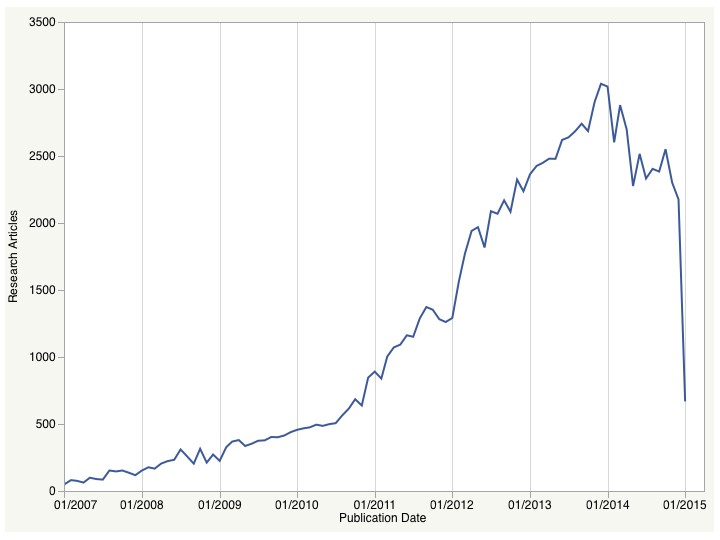
Publication output in the largest open access journal, PLOS ONE, plummeted precipitously in the first month of 2015, declining from 2176 research articles in December 2014 to just 676 articles in January 2015.
The Official PLOS Blog announced this forthcoming slowdown last month. The publisher is undertaking some changes to their workflow and are now working with a new composition vendor. In the end, PLOS hopes these changes will increase the speed, efficiency, and quality of publication.
PLOS’ Article-Level Metrics (ALM) reports allowed me to measure just how long it takes PLOS ONE articles to be published. Analyzing 2,000 research articles published in December 2014, it took a median of 30 days from acceptance to online publication (Interquartile Range [IRQ, 25% to 75%]: 26 to 37 days). While I can only speak anecdotally based on my own experience as an author and the claims many journals make on their website, this seemed rather long.
What surprised me more was the period from article submission to acceptance, which took a median of 123 days (just over 4 months, IRQ: 90 to 164 days). Remember, this is a journal that does not base acceptance on significance or novelty. Reviewers should not be requiring authors to return to the lab for confirmatory experiments, supplementary data, or demand major revisions. While the changes PLOS ONE proposed are intended to shorten the acceptance-to-publication period, it will have no affect on the period from submission-t0-acceptance.
For a journal like PLOS ONE, even small production improvements are desirable if they shorten the publication process or reduce the interventions of humans. PLOS ONE is working toward automation and efficiency–goals that are just as equally valuable to mega-publishers like Elsevier as they are for mega-journals. For a non-profit organization that is sitting on a huge cash surplus, spending on automation in the short-term can help to keep article processing fees low in the long-term.
For a journal that publishes articles on a continuous basis, there may never be a good time to overhaul its production systems. Scheduling this overhaul at the beginning (rather than the end) of the year will have consequences to the journal’s citation standing, however.
For many academic journals, peak citation rates take place beyond the Impact Factor window, meaning after the average article has passed its third calendar year of publication. As a result, articles published early in the year tend to outperform articles published near the end of the year. To improve their Impact Factors, some editors deliberately move articles scheduled for the December issue into the January issue–this technique is often referred to as “front loading.” While this technique can work for many journals, it needs to be balanced by authors’ desire to publish quickly and has implications for funding, promotion and tenure. Front loading also works against the publishers’ need for a steady editorial and publication workflow.
How much does publication date matter when it comes to future citation? For many of the journals I study, bumping article publication forward by a month reduces citation events during the Impact Factor window by about 3%. This is not a big effect but, like interest, it is compounded monthly. In real terms, a January article receiving 10 citations in calendar years two and three is expected to receive just 7 if published in December.
For a small journal, bumping a few articles from one issue to the next is not going to be felt in future citation performance. For a mega-journal like PLOS ONE, shifting thousands of articles later in the calendar year is going to have a very measurable downward effect on its Impact Factor. Fortunately, this effect will not be detected until the journal receives its 2016 Impact Factor (in June 2017). Had this slowdown been planned to take place at the end of 2014, with publication shifted to the beginning of 2015, PLOS ONE would likely perform better in both 2015 and 2016.
I have no doubt that the production changes at PLOS are both necessary and desirable, and, as explained on their blog, “the end result will be gains in speed, efficiency, and quality that will be worth the delays during this transition.” I do wonder if the management understood how the timing of these changes will affect the future measured performance of their journals.
Discussion
16 Thoughts on "Production Plummets at PLOS–But For a Good Reason"
It’s worth noting that PLOS ONE has apparently improved slightly on its times since 2011, when I calculated them based on a sampling approach: http://scholarlykitchen.sspnet.org/2011/10/07/is-plos-one-slowing-down/
But the review time remains the sticking point.
I am not too sure about automation and processing fees being linked. I did not see a decrease in costs as publishing moved from lead to cold type to e production. In fact, some costs went up with greater automation.
Interesting article, thanks. Just a couple of points, though: firstly, PLOS has always been consistent in saying that they don’t care about their journals’ impact factors (and for PLOS ONE in particular). Why not take them at their word on this one, rather than speculating that they are not aware of the possible effects on IF? Secondly, you say: “Reviewers should not be requiring authors to return to the lab for confirmatory experiments, supplementary data, or demand major revisions.” Confirmatory experiments should not be required to increase impact, of course, but it’s valid to ask for additional experiments where the original work is not sufficient to prove the claims being made (i.e. it’s not technically sound).
[Disclaimer: I’m an academic editor at PLOS ONE, but I don’t speak for PLOS in any capacity. These are just my personal opinions.]
I agree, Jake. PLOS has always been consistent about not pandering to their Impact Factors. However, it is clear that authors care about where they publish, that PLOS ONE’s IF drives submissions, and that PLOS needs PLOS ONE financially to support its other journals. Link these together and you have a business strategy.
Let’s not forget PLOS’ pursuit of a provisional impact factor in their early days. This was clearly an attempt to gain an advantage using the impact factor as a measure. So, I don’t think “always” is the case.
Is it worth distinguishing between “getting an impact factor” and “worrying about what that impact factor is”? You can want to be included in a group without caring where you stand in the group.
Being ISI-indexed and having an impact factor is taken as a mark of reputability and reliability, and getting into that list is a good marker that you’re not a dubious operation. For a novel type of journal, like PLOS ONE, it feels like this might well have been a pressing concern.
But this stance is still consistent with not being particularly concerned about whether the impact factor is 1 or 10, and indeed more or less ignoring it once it’s in place.
I think there’s a big difference between disavowing the Impact Factor and pretending that it doesn’t exist or matter to your customers. You can think that academia’s reliance on the IF is wrong and actively work toward change while still recognizing the role it plays for your authors. Meeting your customers’ needs is smart business, and given that PLOS is run by extremely smart and talented businesspeople, I have no doubt that they understand (even if it’s a grudging recognition) that the IF remains important to authors.
If I had to bet the farm on the main reason for the long time between manuscript submission and acceptance, I’d place it on the time spent identifying appropriate peer reviewers, having them agree to do the review, and having them complete the review on time. Plus an academic editor has to look at the reviews (and the paper) carefully before making his/her decision.
It continues to boggle my mind why so few point out that science and research are an enterprise in which intellectual rigour and consideration are paramount, tasks that no machine can (and should!) perform. This is either largely ignored or being treated like the ugly duckling, when it’s in fact a natural limitation of the system, much like our need for food, sleep, and rest.
Perhaps the nascent awareness that a lot of research doesn’t meet the fundamental requirement of reproducibility and clarity will draw a lot more attention to the fact that the goal of maximizing scientific output simply for output’s sake has met its boundaries and requires re-thinking.
How do you automate copyediting? Surely, this must be one of the most time-consuming parts of the production process–unless, of course, PLOS One doesn’t bother with copyediting at all. As more submissions come from abroad from places like China, one would think that copyediting time would increase. Does PLOS One ever turn down a manuscript because it is poorly written?
Yes they do.
“The article is presented in an intelligible fashion and is written in standard English.”
That’s one of their review criteria.
Many authors whose first language isn’t English use editing (and sometimes translation) services before submitting their papers to international journals. From my experience as an author, manuscript editor, and science editor, I’ve come to conclude that many journals no longer do much copyediting, and instead publish as is, or expressly require (as PLOS One does) that the manuscript be thoroughly proofread by the authors or by editors hired by the authors.
There are some programs (like eXtyles and PerfectIt) that help automate some components of copyediting (e.g., enforcing style consistency and and checking the accuracy and formatting of references). But for the most part, to have it done properly, you need a human being. In today’s world of hitting the immediate “bottom line” (even if it hits you back down the road), many journals consider this step too costly, so many have pared it down substantially or done away with it (which probably explains why the content of many papers remains obscure behind long and tangled sentences and poorly presented data), or have farmed it out to contractors.
Phil, Bo-Christer Björk and I conducted a pretty comprehensive study of publication times.
http://openaccesspublishing.org/oa11/article.pdf
or if you want the published version.
http://www.sciencedirect.com/science/article/pii/S1751157713000734
We were limited by the availability of the data but based on the publishers who provide the information the average time submission to acceptance for biomedical journals was 4.65 months and for acceptance to publication 4.82 months. PLOS ONE seems pretty typical for submission to acceptance and relatively quick acceptance to publication. Part of that might be many journals still publish paper additions organized in issues.
From having reviewed for PLOS ONE I believe you are incorrect in assuming that authors are not often required to revise and resubmit their manuscripts after an initial review. Though my experience is limited to a couple of reviews, the authors were asked to make revisions. I have also been a academic editor and reviewer for BMC Medical Education and PeerJ which have similar review policies and virtually every article accepted needs at least minor revisions and many major revisions. Anyone who has been involved in peer review knows much of the variation in review times is do to how quickly the authors get their revisions back. I expect that is true for PLOS ONE as well.
Your point that the end of year is a more propitious time for this sort of production slowdown with regard to impact factor calculations is well taken (and surely was a point of consideration). This production change-over may have been driven by a different measure entirely: the P&L report.
First, there are the transition costs which PLOS may simply have budgeted for in 2015 as opposed to 2014. Second, they may have been considering minimizing impact to 2015 revenues. Assuming that PLOS is still accepting the same number of papers as it was prior to this production slowdown (and this is an assumption), then it is building a backlog of content that it will have to then work through. Presumably its new systems will be more efficient systems and PLOS is betting it will be able to work through this backlog faster, but of course these things often take time to refine and their processing speed may, in fact, be slower for a while yet. Given the volume of papers in PLOS ONE, it may take quite a while to work all the way through the backlog. I don’t know when PLOS recognizes an APC as revenue (upon acceptance vs. upon publication), but if the later, there may have been concerns about limiting overall 2015 throughput as that would have revenue implications.
Slightly off the topic of the post…
The new single column style certainly makes automated pagination simpler for a compositor, and the PDFs will be easier to read on screen. What I find depressing is that seemingly *all* graphics are converted to bitmap and the originals dumped. I hope this is not the case but it seems that way. Happy to be corrected on that.



